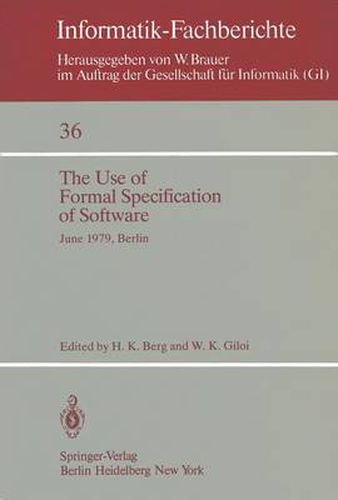Readings Newsletter
Become a Readings Member to make your shopping experience even easier.
Sign in or sign up for free!
You’re not far away from qualifying for FREE standard shipping within Australia
You’ve qualified for FREE standard shipping within Australia
The cart is loading…






This title is printed to order. This book may have been self-published. If so, we cannot guarantee the quality of the content. In the main most books will have gone through the editing process however some may not. We therefore suggest that you be aware of this before ordering this book. If in doubt check either the author or publisher’s details as we are unable to accept any returns unless they are faulty. Please contact us if you have any questions.
The notion that program design is an engineering task alleviating the software crisis has been with us for about a decade. With the recognized advantages of obeying to certain software design disciplines, we are approaching the era of enforced system development standards which will ensure that end products will meet rigorous design requirements. On the one hand, advances in system architecture fUrther the application of system development standards to software and firmware design and production. On the other hand, the growth in complexity of future system architectures, in particular distri buted systems with their special problems of cooperation and parallelism, necessitate the use of rigorous specification and design techniques. In addition to hampering the design process, the lack of engineering techniques hinders research. In many cases, trial designs that are presented in abstract and informal terms do not force the de signer to face the full problem spectrum, and therefore may not sufficiently provide insight into the design process. To prepare for the forthcoming discipline and to provide a snapshot view of recent advances in software and firmware engineering, we organized in June of 1979 a seminar entitled: The Use of Formal Specification of Software and Firmware . The seminar took place at the Heinrich-Hertz-Institute, Berlin, and attracted over 60 participants, most of them from the industry.
$9.00 standard shipping within Australia
FREE standard shipping within Australia for orders over $100.00
Express & International shipping calculated at checkout
This title is printed to order. This book may have been self-published. If so, we cannot guarantee the quality of the content. In the main most books will have gone through the editing process however some may not. We therefore suggest that you be aware of this before ordering this book. If in doubt check either the author or publisher’s details as we are unable to accept any returns unless they are faulty. Please contact us if you have any questions.
The notion that program design is an engineering task alleviating the software crisis has been with us for about a decade. With the recognized advantages of obeying to certain software design disciplines, we are approaching the era of enforced system development standards which will ensure that end products will meet rigorous design requirements. On the one hand, advances in system architecture fUrther the application of system development standards to software and firmware design and production. On the other hand, the growth in complexity of future system architectures, in particular distri buted systems with their special problems of cooperation and parallelism, necessitate the use of rigorous specification and design techniques. In addition to hampering the design process, the lack of engineering techniques hinders research. In many cases, trial designs that are presented in abstract and informal terms do not force the de signer to face the full problem spectrum, and therefore may not sufficiently provide insight into the design process. To prepare for the forthcoming discipline and to provide a snapshot view of recent advances in software and firmware engineering, we organized in June of 1979 a seminar entitled: The Use of Formal Specification of Software and Firmware . The seminar took place at the Heinrich-Hertz-Institute, Berlin, and attracted over 60 participants, most of them from the industry.